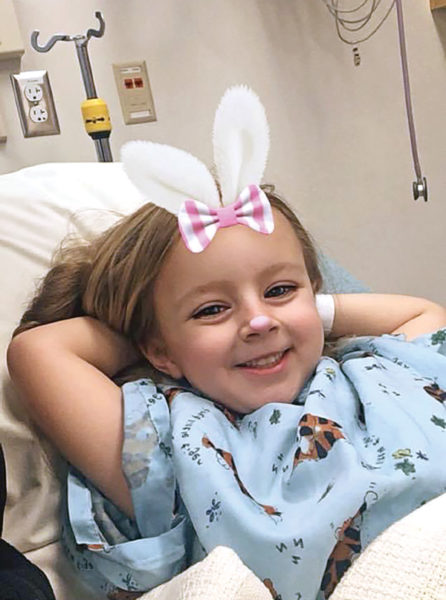What a Team: Addison, age 6, at a follow-up appointment with Alberto Pappo, MD, director of the Solid Tumor Division at St. Jude. Her mom says, “She absolutely adores him.” Photo credit: Ann-Margaret Hedges
Pediatric melanomas are rare and usually different from adult cases. Now St. Jude Children’s Research Hospital has established a genetics registry to learn more about them.
By Sarah Elizabeth Richards
When Jesica Dunavent took her 4-month-old daughter, Addison, to her pediatrician for a checkup, she asked him about a little raised red spot on the infant’s left arm below the elbow. The doctor took one look at the round bump, about half the size of a pencil eraser, and explained it was a hemangioma, a usually harmless birthmark often called a “strawberry mark” that’s common in newborns. “Eventually they go away,” she recalls the doctor saying. “The clusters of blood get reabsorbed into the body.”
Yet by the time Addison was in preschool, her bump was still there. In fact, it had grown to the size of a dime. Occasionally, the child would scratch at it or knock it against furniture and cause it to bleed. Or it would get dry and itch. When the top became scaly in appearance like a mushroom, her parents thought scar tissue was forming and agreed she should visit a dermatologist to have it removed.
That doctor didn’t seem concerned, either. “This is nothing. We see this all the time,” he had said after excising the growth in June of 2017. “But I’m going to send it to a pathology lab [for examination under a microscope] just to make sure.”
Later, when Jesica got a call from the dermatologist’s office asking when she and Addison’s father would be available to talk by phone, her heart sank, and she burst into tears. Jesica, who worked as a medical practice manager in Lambert, Mississippi, knew such a request wasn’t usually good news.
An hour later, the parents learned their 4-year-old daughter had a type of skin cancer called a spitzoid melanoma that is rare in children. She was referred immediately to St. Jude Children’s Research Hospital, which was about an hour and a half away in Memphis, Tennessee. “When I heard the news, I was blindsided,” says Addison’s dad, Caleb Dunavent.
“It was completely out of left field,” adds Jesica. “When I heard the word ‘cancer,’ I felt kicked in the gut.” Consumed with dread, she spent the evening looking up information about melanoma survival rates. “That was probably the worst thing I could have done,” she says. “There was hardly any information about pediatric versions of this cancer.” Indeed, children account for only a tiny percentage of all new cases of melanoma in the United States, with about 400 cases a year in children under 20 years of age.
According to the National Cancer Institute, more than 90 percent of children and adolescents with melanoma were expected to be alive five years after their initial diagnosis. Yet just like in adult cases, the odds of survival were better if that cancer hadn’t spread to other parts of the body. Still, her parents worried about whether their daughter’s cancer had been growing this entire time.
The next task was to tell Addison. “You have to be straight with her. She’s very strong and brave,” says Jesica. “We explained that we were going to a hospital where they take care of kids with cancer and get it taken care of.”
Not the Same as Adult Melanoma
Pediatric melanoma historically has received less research attention because it’s so uncommon, yet doctors increasingly are learning more about the uniqueness of this childhood cancer. One reason is that they have new DNA sequencing tools and are able to study the genetic subtypes and better understand the particular risks. “We have come to recognize that not all pediatric melanoma cases are the same when you compare them to the adult population,” says Alberto Pappo, MD, director of the Solid Tumor Division at St. Jude, who was Addison’s doctor. In fact, the research hospital recently created a registry that follows the progress of pediatric melanoma patients and includes molecular analyses of their cancer subtypes and treatment histories.
The kind that most closely resembles the melanoma that is seen in adults occurs mostly in adolescents ages 15 to 19, who account for 75 percent of all pediatric cases. There’s another type that’s aggressive but extremely rare that afflicts newborns and is characterized by a melanoma that arises in a large congenital nevus, or mole.
The tumors that usually develop in children who are younger than 10 are spitzoid melanomas, which appear as small lesions. The good news is that except for a handful of cases with a certain genetic marker, most spitzoid lesions aren’t life-threatening. “The important thing to know is that these tumors behave very differently from the classic adult melanoma and that most patients have a very good prognosis,” says Dr. Pappo.
When to Take Your Child to a Doctor
The rule of thumb for early detection of melanoma applies to all ages: Watch out for anything new, changing or unusual. Although children’s cases are uncommon, Dr. Pappo advises parents to follow their instincts and ask their pediatrician if a growth is bleeding, getting bigger, changing color or “just doesn’t seem right.” This is especially the case for spitzoid melanomas, which often look bumpy and red — as opposed to the brown moles typically seen in adult cases. “Any of those things should prompt you to go to your pediatrician and eventually your dermatologist,” he says. “In my experience, most of my patients’ cases have been identified because of the persistence of parents.”
The St. Jude Experience
The Dunavents learned the news of Addison’s melanoma on a Thursday. They checked into a hotel near St. Jude the following Sunday night to be on site for Monday’s appointments, which included blood draws and PET and CT scans. When they met Dr. Pappo, they were reassured by his warm, friendly demeanor, as he explained that the bump Addison’s dermatologist had removed was just the outside manifestation of a tumor that had grown deep underneath the skin. She would need surgery to remove the remaining cancer.
During Addison’s surgery a few days later, Dr. Pappo removed the rest of the tumor and then injected a radioactive isotope to check if it had spread. The procedure showed that Addison had cancer in one lymph node, but the doctor was able to remove that, too. “They got it all,” says Jesica. That meant Addison wouldn’t have to undergo any chemotherapy or radiation. Then her tumor tissue was sent to the lab to learn more about its genetic makeup.
- Model Patient: Addison was very upbeat during her treatment at St. Jude, her mom says: “silly, dancing and giggly from the beginning.” Photo credit: Jesica Dunavent
- A Champ: Addison was such a good patient, she even got a St. Jude medal. Photo credit: Jesica Dunavent
The family was relieved. They were also grateful that St. Jude’s business model does not charge families for medical care or related expenses. “Everything is free,” says Jesica, ticking off the list of complementary lodging, meals, transportation and activities like movie and pizza night, dominoes or karaoke. “You have to experience it to understand how amazing it is.”
Caleb says he appreciated the financial and emotional support during such an anxious time. “You can give a hundred percent to your child instead of worrying about how you are going to pay for everything,” he says. “We were able to meet other families who were going through the same thing we were, or even worse.”
What Cancer Genes Can Reveal
Addison’s tumor contained what’s called a MAP3K8 fusion, which is a combination of two genes that have broken down and come together and created abnormal cell growth. What was significant about her report is that it showed she didn’t have a certain genetic mutation called TERT that is associated with a rare kind of dangerous spitzoid melanoma that can spread quickly. “More and more, we are relying on genomic information to guide us as to how we’re going to treat the patient and how we’re going to intervene in our follow-up,” says Dr. Pappo. In fact, a study published in December 2021 showed that pathologists who used genetic information in addition to looking at patients’ tumors under a microscope were able to more accurately diagnose their cancer and predict which ones would behave aggressively and spread.
Addison’s DNA report gave Dr. Pappo important information about how to approach her care. “Knowing which types of genes were involved can tell us more about how the tumor is going to behave long term,” he says. Addison’s genetic profile confirmed that her cancer was the kind of spitzoid melanoma that was unlikely to return. Dr. Pappo explained to the Dunavents that Addison’s cancer was sporadic and that she didn’t inherit the genes that caused it. “It just happens,” he says.

Young Lady: Now 9, Addison still goes for regular checkups at St. Jude. She’s also a cheerleader and dancer and loves to cook. Photo credit: Jesica Dunavent
Addison is 9 now. She loves cheerleading, dance, cooking and hanging out with her friends. Every six months she returns to St. Jude for monitoring to make sure she’s cancer-free. And her parents carefully watch for any new moles that pop up; one appeared on top of her surgery scar a few years ago, and her dermatologist removed it as a precaution.
Even though Addison’s cancer wasn’t caused by sun exposure, Jesica says she’s become extra vigilant in preventing potential adult melanoma by applying sunscreen on her daughter daily and found a 50 SPF brand with a “yummy” smell that Addison likes. “Before that, she always complained that she smelled like a pool,” she says.
Her daughter’s cancer scare also has motivated her to regularly monitor her own moles and get them checked by a dermatologist. “It’s definitely something I think more about,” she says. “If there’s a spot that looks abnormal or has changed, it’s better to learn that it was nothing than to find out it’s something and you missed it.
Sarah Elizabeth Richards is a San Diego-based journalist who writes about health and science.







